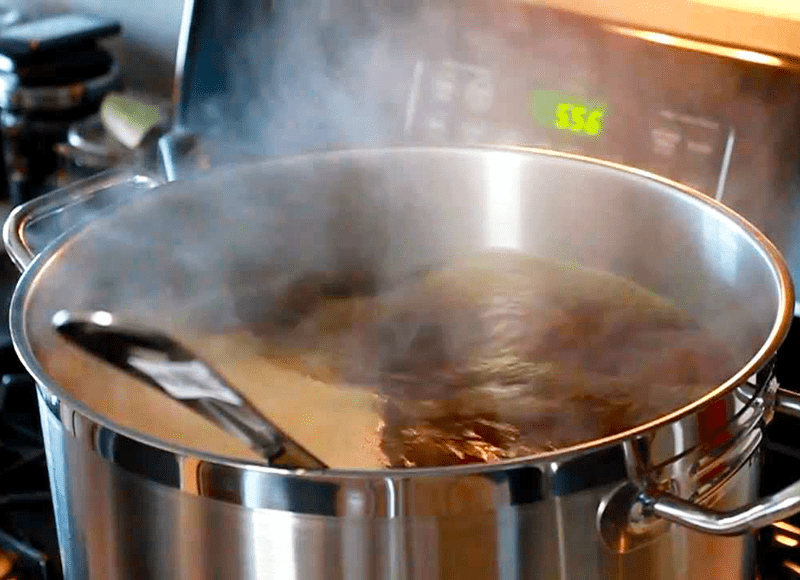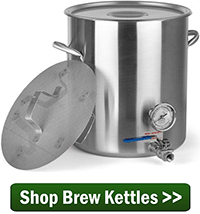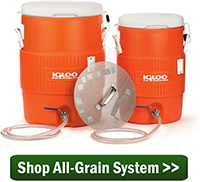 Are you feeling restricted by the size of your brew kettle? Do you want to brew 10, 20, or 30 percent more beer without buying any new homebrewing equipment? Fortunately, there’s a way you can by using a process called high gravity brewing.
Are you feeling restricted by the size of your brew kettle? Do you want to brew 10, 20, or 30 percent more beer without buying any new homebrewing equipment? Fortunately, there’s a way you can by using a process called high gravity brewing.
Many home brewers start out with a five-gallon brew kettle. It works great for brewing extract and partial mash beer recipe kits – and it’s easy on the budget. But if you’re trying to advance to all-grain brewing – whether with brew-in-a-bag or with a mash tun cooler – it can be hard to brew a full five-gallon batch of beer with the five-gallon kettle. Luckily, there’s a way to “cheat”: brew a higher gravity beer and dilute it down with water after the fermentation.
Just like we do with extract and partial mash brewing, it’s perfectly acceptable to dilute your wort or beer with water to make it go further. Alternatively, you can use this high gravity brewing process to take your five-gallon batch of beer (or any size batch for that matter) and dilute it to make more.
Here or some basic high gravity brewing tips:
- Water should be pre-boiled to sterilize and de-aerate it, and then chilled to match the temperature of the wort or beer.
- Keep your dilution rates to a reasonable level. Around 20% is okay, and up to 40% would be fine with certain beer styles, doubling the batch size is not realistic.
- Blending down your wort pre-fermentation may lead to higher ester production. Depending on your beer recipe, you may prefer to blend after fermentation.
- When diluting your beer after fermentation, avoid splashing. Splashing can introduce air back into your beer, which negatively impacts shelf life.
 The high gravity brewing process couldn’t be easier. To amp up your five gallon recipe to a six gallon recipe, simply increase your ingredients by 20%. (If desired, use a brewing calculator to calculate hop changes to account for the change in hop utilization.) Depending on your beer recipe, you may need to tweak your yeast pitch rate, but in most situations you won’t need to worry about it. After fermentation, add your gallon of pre-boiled, pre-chilled water to either the secondary fermenter or the bottling bucket, taking care not to splash. Siphon the beer into the water to mix it together.
The high gravity brewing process couldn’t be easier. To amp up your five gallon recipe to a six gallon recipe, simply increase your ingredients by 20%. (If desired, use a brewing calculator to calculate hop changes to account for the change in hop utilization.) Depending on your beer recipe, you may need to tweak your yeast pitch rate, but in most situations you won’t need to worry about it. After fermentation, add your gallon of pre-boiled, pre-chilled water to either the secondary fermenter or the bottling bucket, taking care not to splash. Siphon the beer into the water to mix it together.
If you’d like to experiment, you can even bottle part of your batch at the original strength and the rest at the diluted rate. It takes a little extra time to figure out the blending ratios, but luckily there’s an easy formula!
Blending Formula For High Gravity Brewing
Use this formula to calculate how blending or diluting the wort or beer will change your gravity, IBUs, alcohol content – even beer color:
A1 * B1 = A2 * B2
A1 = gravity, IBUs, ABV, or color (SRM) of the first beer
B1 = volume of the first beer
A2 = gravity, IBUs, ABV, or color (SRM) of the second beer
B2 = volume of the second beer
It doesn’t matter which recipe is the “first” or “second” beer, as long as you don’t mix up your stats between the two.
So, for example, the beer you want to make has an expected ABV of 5% (A1). You want to end up with six gallons of the beer (B1). At what ABV (A2) should you brew your five-gallon batch (B2) in order to add one gallon of water and end up at 5% ABV?
5 * 6 = x * 5
x = 6% ABV
The calculation also works for gravity. You want your wort to have an OG of 1.040, but you have five gallons of wort at 1.050. How much water should you add to reach 1.040? (Use gravity points: 1.040 becomes 40.)
40 * B1 = 50 * 5
Answer? Your target volume of wort should be 6.25 gallons, so you should add 1.25 gallons of water.
The advantages of high gravity brewing are many: less equipment, less space, more variety… But beyond this, it’s easy to do and doesn’t require any significant, additional effort on your part. So I say, why not give the high gravity brewing process a shot and see what you come up with!
—–
David Ackley is a beer writer, brewer, and self-described “craft beer crusader.” He holds a General Certificate in Brewing from the Institute of Brewing and Distilling and is founder and editor of the Local Beer Blog.
